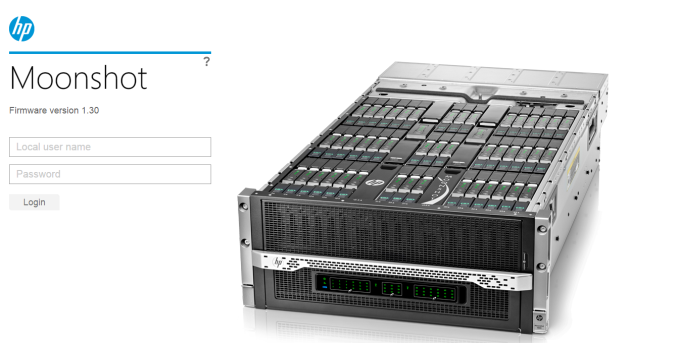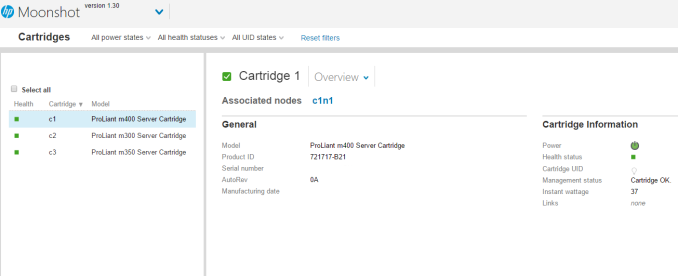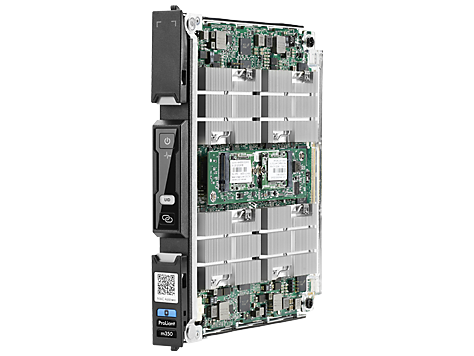X-Gene 1, Atom C2000 and Xeon E3: Exploring the Scale-Out Server World
by Johan De Gelas on March 9, 2015 2:00 PM ESTHP Moonshot
We discussed the HP Moonshot back in April 2013. The Moonshot is HP's answer to SeaMicro's SM15000: a large 4.3U chassis with no less than 45 cartridges that share three different fabrics: network, storage, and clustering. Each cartridge can contain one to four micro servers or "nodes". Just like a blade server, cooling (five fans), power (four PSUs), and uplinks are shared.
Back in April 2013, the only available cartridge was based on the anemic Atom S1260, a real shame for such an excellent chassis. Since Q4 2014, HP now offers six different cartridges ranging from the Opteron X2150 (m700) to the rather powerful Xeon E3-1284Lv3 (m710). The different models are all tailored to specific workloads. The m700 is meant to be used in a Citrix virtual desktop environment while the m710 is targeted at video transcoding. We tested the m400 (X-Gene 2.4), m300 (Atom C2750), and m350 (four Atom C2730 nodes) cartridges.
The m400 is the first server we have seen that uses the 64-bit ARMv8 AppliedMicro X-Gene. HP positions the m400 as the heir of mobile computing, and touts its energy efficiency. Other differentiators are memory bandwidth and capacity. The X-Gene has a quad-channel memory controller and as a result is the only cartridge with eight DIMMs. We were very interested in understanding how X-Gene would compare to the Intel Xeons. HP positions the m400 as the micro server for web caching (memcached) and web applications (LAMP). The m400 also comes with beefy storage: you can order a 480GB SSD with a SATA or M.2 interface.
The m300 cartridge is based on the Atom C2750 with support for up to 32GB of RAM. HP positions this cartridge as "web infrastructure in a box". The m400 is mostly about web caching and the web front-end while the m300 seems destined to run the complete stack (front- and back-end). However, it is clear that there is some overlap between the m300 and m400 as there's nothing to stop you from running a complete "web infrastructure" on the m400 if it runs well in 32GB or less.
The m350 cartridge is all about density: you get four nodes in one cartridge. There is a trade-off however: you are limited to 16GB of RAM and can only use M.2 flash storage, limited to 64GB.
Each node of the m350 is powered by one of Intel's most interesting SKUs, the 1.7GHz 8-core Atom C2730 that has a very low 12W TDP. The m350 is positioned as a way to offer managed hosting on physical (as opposed to virtualized) servers in a cost effective way.













47 Comments
View All Comments
JohanAnandtech - Tuesday, March 10, 2015 - link
Thanks! It is been a long journey to get all the necessary tests done on different pieces of hardware and it is definitely not complete, but at least we were able to quantify a lot of paper specs. (25 W TDP of Xeon E3, 20W Atom, X-Gene performance etc.)enzotiger - Tuesday, March 10, 2015 - link
SeaMicro focused on density, capacity, and bandwidth.How did you come to that statement? Have you ever benchmark (or even play with) any SeaMicro server? What capacity or bandwidth are you referring to? Are you aware of their plan down the road? Did you read AMD's Q4 earning report?
BTW, AMD doesn't call their server as micro-server anymore. They use the term dense server.
Peculiar - Tuesday, March 10, 2015 - link
Johan, I would also like to congratulate you on a well written and thorough examination of subject matter that is not widely evaluated.That being said, I do have some questions concerning the performance/watt calculations. Mainly, I'm concerned as to why you are adding the idle power of the CPUs in order to obtain the "Power SoC" value. The Power Delta should take into account the difference between the load power and the idle power and therefore you should end up with the power consumed by the CPU in isolation. I can see why you would add in the chipset power since some of the devices are SoCs and do no require a chipset and some are not. However, I do not understand the methodology in adding the idle power back into the Delta value. It seems that you are adding the load power of the CPU to the idle power of the CPU and that is partially why you have the conclusion that they are exceeding their TDPs (not to mention the fact that the chipset should have its own TDP separate from the CPU).
Also, if one were to get nit picky on the power measurements, it is unclear if the load power measurement is peak, average, or both. I would assume that the power consumed by the CPUs may not be constant since you state that "the website load is a very bumpy curve with very short peaks of high CPU load and lots of lows." If possible, it may be more beneficial to measure the energy consumed over the duration of the test.
JohanAnandtech - Wednesday, March 11, 2015 - link
Thanks for the encouragement. About your concerns about the perf/watt calculations. Power delta = average power (high web load measured at 95% percentile = 1 s, an average of about 2 minutes) - idle power. Since idle power = total idle of node, it contains also the idle power of the SoC. So you must add it to get the power of the SoC. If you still have doubts, feel free to mail me.jdvorak - Friday, March 13, 2015 - link
The approach looks absolutely sound to me. The idle power will be drawn in any case, so it makes sense to add it in the calculation. Perhaps it would also be interesting to compare the power consumed by the differents systems at the same load levels, such as 100 req/s, 200 req/s, ... (clearly, some higher loads will not be achievable by all of them).Johan, thanks a lot for this excellent, very informative article! I can imagine how much work has gone into it.
nafhan - Wednesday, March 11, 2015 - link
If these had 10gbit - instead of gbit - NICs, these things could do some interesting stuff with virtual SANs. I'd feel hesitant shuttling storage data over my primary network connection without some additional speed, though.Looking at that moonshot machine, for instance: 45 x 480 SSD's is a decent sized little SAN in a box if you could share most of that storage amongst the whole moonshot cluster.
Anyway, with all the stuff happening in the virtual SAN space, I'm sure someone is working on that.
Casper42 - Wednesday, April 15, 2015 - link
Johan, do you have a full Moonshot 1500 chassis for your testing? Or are you using a PONK?